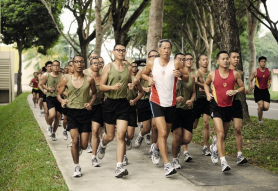AN SAF THAT ADAPTS TO CHANGE
PHOTO // Chua Soon Lye and Chai Sian Liang
A month after taking over as Minister for Defence, Dr Ng Eng Hen gives his take on today's Singapore Armed Forces (SAF) and outlines three areas the SAF must focus on.
"We have come a long way," said Dr Ng. From just two infantry battalions, 50 officers, 1,000 men and two ships 46 years ago, the SAF has since developed into a complex, well-trained and technologically-capable organisation.
He attributed this to the SAF having dedicated commanders and Full-time National Servicemen with strong leadership and clear vision, as well as to steady defence investments over the years. Dr Ng was speaking with local media on 28 Jun, ahead of SAF Day, at the Basic Military Training Centre on Pulau Tekong.
Despite the SAF's progress, Dr Ng said that Singapore remained vulnerable as new spheres of influence would develop in the Asia-Pacific region in the next two decades. This is because emerging Asian countries have embarked on modernising their military forces to protect their increased wealth and assets. In the light of such global shifts, the SAF needs to focus on three areas to adapt to changes.
1) Remain relevant to soldiers
The first is that National Service remains critical for defence, as "we cannot expect others to defend us if we are not prepared to do it ourselves", said Dr Ng.
Noting the influx of better-educated and more tech-savvy soldiers, he emphasised that the SAF must adapt its training methods and platforms to remain relevant to each new generation.
"The SAF must continue to upgrade its training methods and equipment because we have to maximise the abilities of national servicemen today," said Dr Ng, giving examples of soldiers using high-tech equipment in the field such as the Advanced Combat Man System, and learning basic soldiering skills through the technology-enabled platform LEARNet.
Besides the need to engage the minds of soldiers, the SAF also has to engage their hearts. One example he gave was how soldiers who ended their Basic Military Training (BMT) graduation march in Marina Bay gave feedback that the march into the city helped them understand what they were protecting.
Dr Ng added that Minister of State for Defence and Education Lawrence Wong Shyun Tsai and Senior Parliamentary Secretary for Defence and National Development Dr Mohamad Maliki Bin Osman had been tasked to explore ways to further engage national servicemen.
He also paid tribute to Operationally Ready National Servicemen for their sacrifices, and said: "We will continue to find tangible ways to acknowledge and appreciate their contributions."
2) Invest in people, hardware
Since 2002, defence spending has been between 4.5 percent and 5 percent of Singapore's Gross Domestic Product. Said Dr Ng: "This stable defence budget allows us to make long-term decisions in order to obtain the best value for our investments, whether it is in people or in weapon systems.
"We will continue this prudent approach of steady investments for our defence."
Illustrating how the Republic of Singapore Navy's Formidable-class frigates took about 15 years from conception to full integration with land and air assets, Dr Ng explained that as defence systems and capabilities took time to develop, steady investments needed to continue over a protracted period of time.
Upcoming developments in the SAF Dr Ng mentioned include the Army launching the first High Mobility Artillery Rocket System battery, the Navy operating a National Maritime Security System, and the Air Force taking delivery of the Heron 1 Unmanned Aerial Vehicle (UAV) to replace the Searcher-class UAVs which have been in service since the 1990s.
Besides investing in hardware, developing its personnel remains a priority for the SAF, said Dr Ng. "The thinking, well-trained SAF soldier is still our greatest asset, and we'll continue to invest in high-calibre servicemen with the right values and capabilities, so that they're ready to confront security challenges."
Plans in the pipeline for the professional development of SAF personnel include more tie-ups with universities to find relevant courses for servicemen.
3) Cooperate with others
The SAF has to engage in defence diplomacy to shape a peaceful and stable security environment for this region and for Singapore.
Citing examples of Singapore hosting the annual security and defence dialogue, the Shangri-La Dialogue, and its involvement in the ASEAN Defence Ministers' Meeting (ADMM) and the ADMM-Plus, Dr Ng highlighted that Singapore played a meaningful role in building on the security architecture and facilitating dialogue in the region.
Beyond the region, Dr Ng confirmed the SAF's continued deployment of troops to support international efforts to stabilise Afghanistan and deter piracy in the Gulf of Aden. In his conclusion, he noted that change is inevitable and that "you just have to go with the flow and adapt to them".
He added: "We have to ensure that the SAF continues to be able to meet its challenges, and for us to be able to build our defence capabilities."










